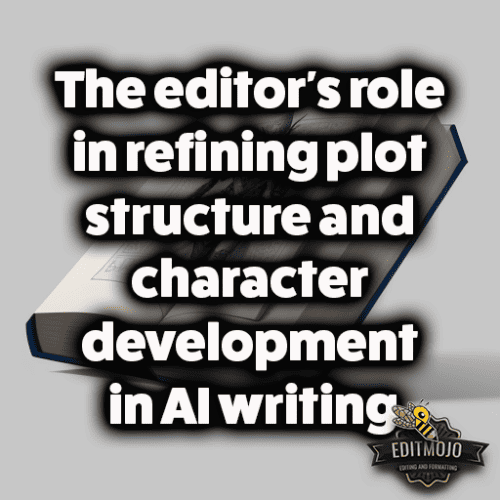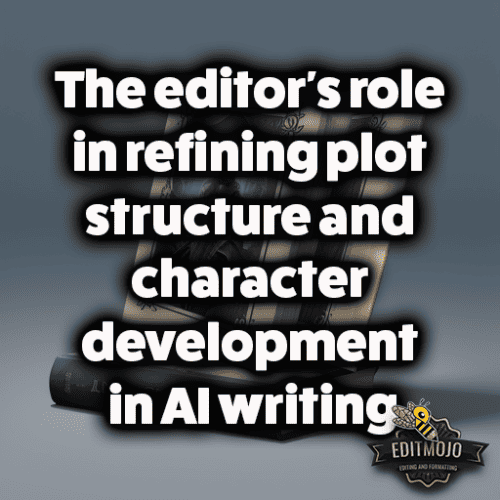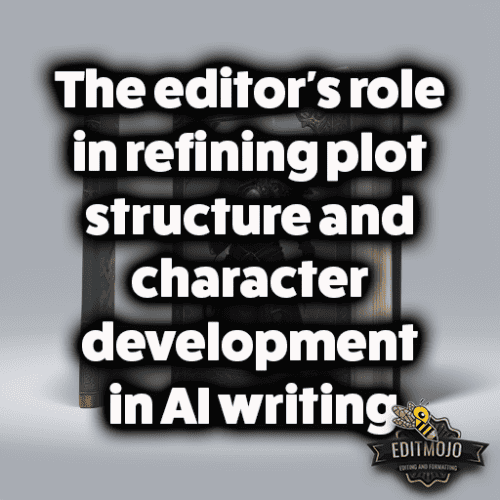The editor’s role in refining plot structure and character development in AI writing
The editor’s role in refining plot structure and character development in AI writing. It is an undeniable fact that artificial intelligence (AI) has begun to permeate every corner of our lives, including the realm of writing. With AI generating articles, poetry, and even attempts at novels, we might wonder: where does this leave the human element in storytelling? More specifically, what is the role of an editor in this brave new world? This article takes a deep dive into how editors refine plot structure and character development in AI writing, maintaining a critical human touch in a machine-driven world.
Key Takeaways Table
| Takeaway Points | Explanation |
|---|---|
| AI’s Writing Capabilities | AI can generate vast amounts of text and provide original ideas but often lacks emotional depth and narrative coherence. |
| The Editor’s Role | Editors play a critical role in shaping AI’s raw narrative into a structured, engaging plot and developing nuanced, consistent characters. |
| Editing Techniques | Editors should understand the AI’s strengths and weaknesses, use it as a brainstorming tool, and apply their human creativity to refine the AI-generated content. |
| The Power of Collaboration | The synergy between human and artificial intelligence can result in unique and engaging narratives. |
| The Future of Editing | As AI’s writing capabilities evolve, the role of the editor will become more crucial in shaping the AI-generated narratives and preparing them for human consumption. |
Understanding AI Writing
AI has displayed an impressive ability to generate text based on given prompts or data sets. However, despite its impressive capabilities, AI is fundamentally a pattern-recognition tool. This means that while it can mimic human writing, there’s a crucial piece it often misses: the nuances and subtleties that make stories truly resonate with readers. AI’s plot structuring and character development capabilities, while improving, still have limitations that require the deft touch of a human editor to truly shine.

The Editor’s Role: A Deep Dive
Editors have long been the unsung heroes of the writing world. They shape, refine, and polish writers’ raw ideas into structured, coherent, and compelling narratives. Their roles in traditional writing have always been essential. But in the context of AI writing, their roles become even more critical.
While AI can generate content rapidly, it often lacks the cohesive narrative arc or consistent character development that makes a story engrossing. This is where the editor steps in, adding their human understanding of storytelling to shape AI’s raw narrative into a compelling plot with well-rounded characters.
Plot Structure: Refining AI’s Storytelling
A well-structured plot is like a roadmap for a story. It guides the reader through the narrative, ensuring a logical progression of events, introducing conflicts and resolutions, and weaving together narrative arcs and sub-plots.
AI, for all its capabilities, often struggles with creating such a roadmap. It might generate a fascinating premise or intriguing incidents but stringing them together coherently can be challenging. This is akin to having puzzle pieces, but lacking the bigger picture to put them together correctly.
An editor’s role is analogous to the one assembling that puzzle. They ensure continuity in the narrative, introduce conflict and resolution where the AI fails to do so, and weave in narrative arcs and subplots to enrich the story. They act as the guiding hand that steers the AI’s creativity towards a well-structured plot.
Character Development: Humanizing AI’s Characters
If the plot is the backbone of a story, characters are its beating heart. Robust character development makes characters feel real and relatable, makes readers invest emotionally in their journeys. AI, with its endless possibilities, can indeed create a wide range of characters. However, these characters often lack the emotional depth and consistency that make them truly memorable.
The editor, armed with an understanding of human psychology and emotions, can breathe life into these AI-generated characters. They ensure consistency in the characters’ actions and reactions, enhance their emotional depth, and weave complex relationships that make the story rich and multidimensional.
Take, for instance, the case of OpenAI’s GPT-3. While it can generate fascinating characters, an editor’s expertise is needed to maintain consistency and depth in these characters throughout the story.
Practical Tips for Editors: Refining AI Writing
Working with AI as a co-creator requires a blend of creativity, technical know-how, and adaptability. Editors should familiarize themselves with various AI writing tools and learn how to guide them effectively.
An important strategy is to understand the AI’s capabilities and limitations, and to use it as a brainstorming partner. Generate ideas with the AI, then use human creativity to refine these ideas into a compelling narrative. For character development, editors can leverage AI to create diverse characters, then add depth and consistency to these characters.

Case Studies
Success stories abound in the field of AI writing post-editing. Keiichi Matsuda’s experience with GPT-3 is a great example. By using GPT-3 as a brainstorming partner, then applying his own creativity and editing skills, Matsuda managed to write a short film that blended AI’s productivity with human creativity.
The Future of AI Writing and Editing
While AI’s writing capabilities will continue to evolve, the need for a human editor is unlikely to wane. Instead, editors’ roles will shift towards guiding AI, shaping its outputs into compelling narratives, and enhancing the emotional depth of its characters. This new era presents exciting opportunities for editors willing to adapt and evolve alongside AI.
In conclusion, embracing AI as a tool, rather than seeing it as a threat, can lead to an enriching blend of productivity and creativity. After all, at its heart, storytelling is a deeply human endeavor, and AI is another tool we can use to share our stories with the world.
For further reading, check out this article that explores how AI is transforming the future of storytelling.
From Machine-Created to Human-Refined: The Process
The art of refining machine-generated text is akin to sculpting. The raw text produced by the AI is like a block of marble, and the editor is the sculptor, chiseling away inconsistencies, smoothing out the character arcs, and adding detail where necessary to bring out the plot structure.
The process usually begins with an overview reading to identify main plot points and characters. Editors will assess if the narrative has a clear beginning, middle, and end, and whether it follows traditional or experimental narrative structures.
Next, the focus moves to individual character analysis. Here, the consistency of each character’s attributes, motivations, actions, and dialogue is inspected. Editors will ensure that each character’s development follows a logical trajectory and that their interactions with other characters feel authentic and compelling.
The beauty of refining AI writing is that editors often have the freedom to make significant changes. If a character lacks depth or a plot twist feels forced, editors can reimagine these elements. This is a unique and exhilarating creative opportunity, blurring the lines between editor and writer.
The Magic of Collaborative Creativity
This blend of AI and human creativity results in a unique kind of storytelling magic. While the AI can churn out vast amounts of text with original ideas, the human editor ensures these ideas form a coherent, engaging narrative with authentic characters.
This collaborative creativity also extends beyond the written word. In the world of screenwriting, for instance, AI can be used to generate scenarios, characters, and dialogues. Editors then step in to refine these elements, ensuring they align with the screenplay’s overall vision.
One notable example is “Sunspring”, a short film entirely written by an AI and then edited by humans. The result is a piece that is distinctly unique, both familiar and uncanny, reflecting the amalgamation of machine randomness and human sense-making.

AI and Editor: A Future Together
Despite the rapid advancements in AI, there’s an irreplaceable aspect that human editors bring to the table – the understanding and application of human emotion and experience. This human touch transforms AI-generated text from a series of logically connected sentences to a relatable narrative that can make readers laugh, cry, or ponder deep existential questions.
As we continue to venture into the AI era, one thing becomes clear: the role of human editors is not diminishing, but rather evolving. As AI technology improves, the stories it generates will become more complex, and the role of the editor more crucial than ever.
Remember, every technological advancement in history has not replaced humans but rather changed the way we work, creating new opportunities and challenges. AI writing and editing are no different. By embracing this change, editors can look forward to a future full of creative collaboration with AI, crafting narratives that resonate with readers on a deeply human level.
Conclusion (The editor’s role in refining plot structure and character development in AI writing)
The intersection of AI and editing is an exciting frontier, ripe with opportunities for those willing to embrace this blend of technology and creativity. The role of an editor in refining AI writing is critical in ensuring that the technology’s output is not just structurally sound and consistent, but also engaging and emotionally resonant. As we move forward, we should see AI not as a replacement for human creativity, but as a powerful tool that complements it. As we’ve seen, the most captivating stories often come from the synergy between human and artificial intelligence, a collaboration that elevates storytelling to new, uncharted heights.
Top Five Questions and Answers Table
| Questions | Answers |
|---|---|
| How does AI contribute to the writing process? | AI can generate vast amounts of text rapidly, offering original ideas and characters. |
| What are the limitations of AI writing? | AI often lacks emotional depth and narrative coherence in its writing, and it might struggle with creating a well-structured plot or consistent characters. |
| What role does an editor play in refining AI writing? | An editor ensures continuity in the narrative, introduces conflict and resolution, and enhances the emotional depth of characters. Essentially, they shape the AI’s raw narrative into a compelling story. |
| How can editors effectively work with AI? | Editors can effectively work with AI by understanding its capabilities and limitations, using it as a brainstorming tool, and then applying their own creativity to refine the AI-generated content. |
| What does the future hold for AI writing and editing? | As AI’s writing capabilities continue to evolve, the need for a human editor is unlikely to wane. Instead, editors’ roles will shift towards guiding AI, shaping its outputs into compelling narratives, and enhancing the emotional depth of its characters. |
